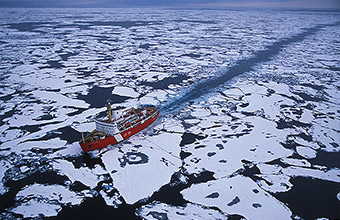Background

###About the Beaufort Sea
The Beaufort Sea is home to an incredibly rich diversity of species, like the tens of thousands of beluga whales that migrate there annually to feed and breed. The Beaufort Sea is one of the belugas primary Arctic summering areas, and plays a critical role in their ability to thrive long-term. Today, as it has for thousands of years, the bounty of the Beaufort Sea supports the livelihoods and culture of the Inuvialuit, Inupiat, and Gwich’in peoples in Canada and Alaska.
##Why the research is important
As Arctic sea ice declines, interest in development – especially oil and gas exploration and shipping – grows, raising some critical questions about balancing risks and benefits for the people of the Beaufort Sea, as well as across Canada and the global Arctic. To help answer those questions, WWF has commissioned world-class scientific research modelling how different types of oil spills would spread in the Beaufort Sea, and how the spills would overlap with significant areas for Arctic species, pristine/healthy ecosystems, and the local communities that depend on them.
A clear understanding of how oil spills would behave in the Beaufort Sea is essential for informed planning and development decisions. The results of this research are intended to: help Northerners and Canadians fully understand the scale and nature of the risks of oil spills; inform critical ocean management and planning; and support oil spill response planning should these development projects proceed.
Research of this kind has never before been done at this scale for the Beaufort Sea. In a region where the dynamics of seasonal and multi-year sea ice and the powerful Beaufort Gyre current could result in very different ecological impacts than other oil spills, detailed and accurate modelling is essential. An oil spill in the Arctic would be extremely difficult to stop — in some scenarios, it is unlikely that a spill could be capped before the winter freeze-up, meaning that it would spew continually for eight months beneath the ice. The damage to sensitive Arctic ecosystems, species and people could be devastating and irreversible - and widespread.
##WWF in the Arctic
WWF has been working in the Arctic for over 40 years, supporting key research, providing on-the-ground support for wildlife conservation initiatives, and collaborating with local communities.
WWF is working to ensure that key Arctic habitats are conserved for important wildlife species and the people who depend on them. In the Beaufort Sea, WWF-Canada is working with local communities to ensure that ecologically significant areas are conserved - to protect key wildlife and habitats, and respect cultural values. In some cases, this will involve determining which areas are too sensitive or important to support some types of development, such as oil and gas development.
To help Arctic ecosystems stay in balance, WWF-Canada is planning for an Arctic future that conserves wildlife while respecting the practices and traditions of local communities, and promoting the responsible development of Arctic resources. We do this through scientific research, by working with communities, industry, Indigenous groups and government, by empowering young people to speak out for the Arctic, and by furthering national and international efforts to reduce greenhouse gas emissions and slow rapid climate change.
Learn more about our work in the Canadian and global Arctic, and get the latest updates on our blog.